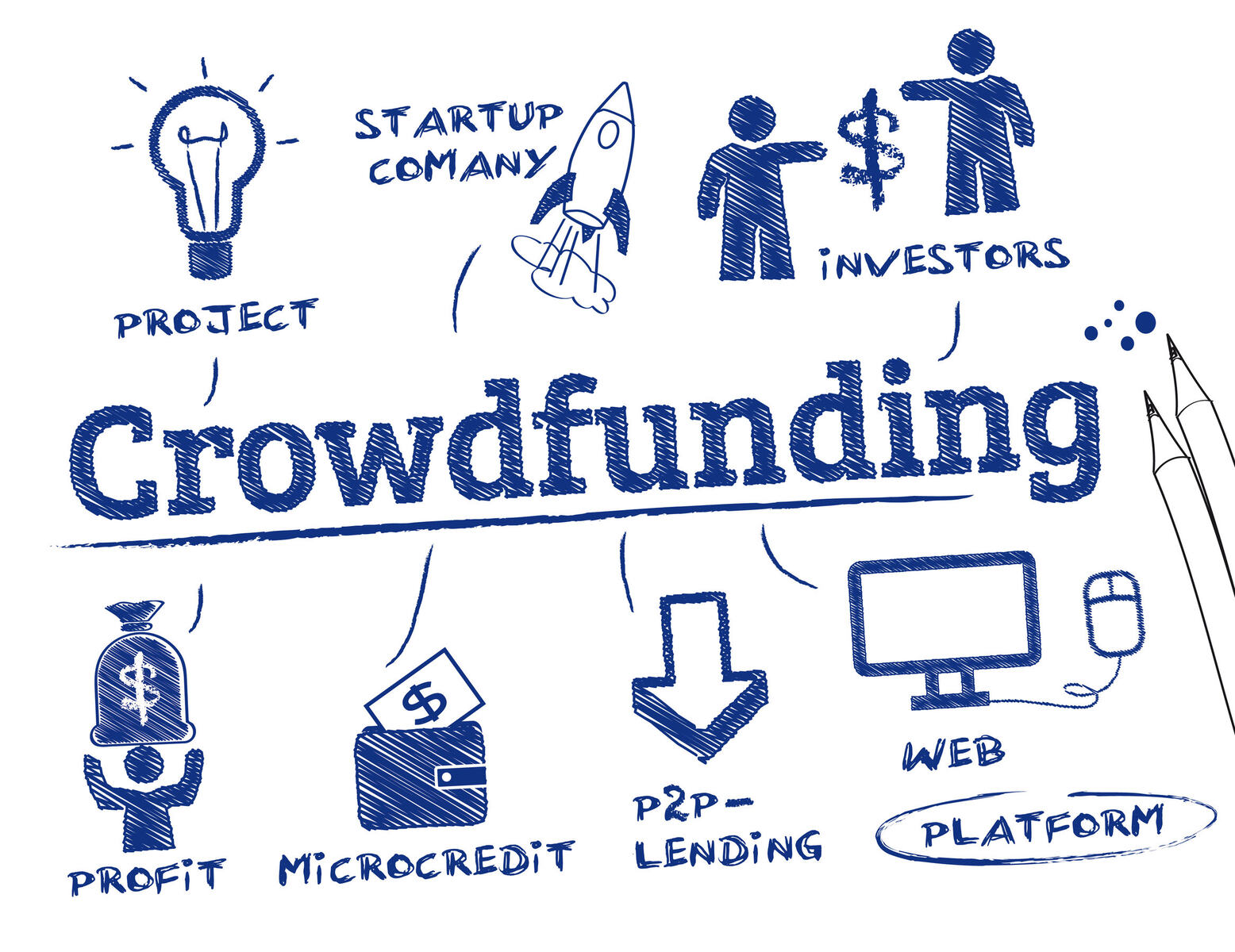Introduction
Welcome to the world of crowdfunding! Crowdfunding has revolutionized the way entrepreneurs, artists, and creators raise funds for their projects. Whether you have a brilliant business idea or a passion project you want to bring to life, crowdfunding provides a platform to connect with a supportive community of backers.
In this article, we will guide you through the essential steps to create a successful crowdfunding campaign. From finding a compelling idea to managing the post-campaign marketing efforts, we will cover everything you need to know to maximize your chances of reaching your funding goals.
Crowdfunding offers an opportunity to validate your idea, build a loyal community, and gain financial support without relying solely on traditional lenders or investors. It allows you to harness the power of the crowd’s collective support, turning them into backers who are not just investing in your project but becoming advocates and ambassadors for your cause.
However, running a successful crowdfunding campaign is not as simple as posting an idea and waiting for the funds to roll in. It requires careful planning, strategy, and execution. This article will provide you with the knowledge and tools to navigate the crowdfunding landscape and increase your chances of success.
So, if you are ready to embark on a crowdfunding journey, let’s dive in and discover the key steps to make your campaign a roaring success.
Finding a Compelling Idea
Before launching a crowdfunding campaign, you need to have a compelling and unique idea that captures the attention and interest of potential backers. Your idea should solve a problem or fulfill a need in the market, while also resonating with your target audience. Here are some steps to help you find that winning idea:
- Identify Your Passions and Interests: Start by brainstorming and exploring your personal interests, hobbies, and expertise. Look for gaps or opportunities within these areas where you can create something innovative and valuable.
- Research Market Trends: Conduct thorough market research to identify current trends and consumer demands. Look for gaps in the market that you can fill, or ways to improve upon existing products or services.
- Seek Inspiration from Successful Campaigns: Study successful crowdfunding campaigns in your niche or industry. Analyze what made them successful, the problems they solved, and how they engaged with their backers. Use these insights to inspire and guide your own campaign.
- Think Outside the Box: Don’t be afraid to think outside traditional boundaries and explore innovative ideas. Look for unique angles or approaches that set your project apart from others. This could be through a new technology, a social cause, or a creative twist.
- Validate Your Idea: Once you have a potential idea, validate it by seeking feedback from your target audience. Engage with potential backers, gather their opinions, and incorporate their suggestions to fine-tune and strengthen your concept.
Remember, a compelling idea not only captures the interest of backers but also provides them with a tangible benefit or solution. It should evoke an emotional response, whether it’s excitement, curiosity, or a sense of urgency.
By investing time and effort into finding a compelling idea, you lay the foundation for a strong crowdfunding campaign that is more likely to resonate with your audience and attract the support you need.
Setting Clear Goals and Objectives
Setting clear goals and objectives is a crucial step in planning a successful crowdfunding campaign. Without a clear direction, it will be challenging to measure progress and determine whether your campaign is on track. Here are some key points to consider when setting your campaign goals and objectives:
- Determine Your Funding Target: Decide on the amount of funding you need to bring your project to life. Consider all the expenses involved, including production costs, marketing fees, and any additional charges. Be realistic with your funding target, ensuring it is attainable yet sufficient to achieve your goals.
- Define Milestones: Break down your campaign into milestones or funding stages. This allows you to track progress and create a sense of achievement for both yourself and your backers. For example, you can set stretch goals to unlock additional features or rewards when certain funding milestones are reached.
- Identify Key Performance Indicators (KPIs): Determine the metrics you will use to evaluate the success of your campaign. These could include the number of backers, the amount of funds raised, social media engagement, or website traffic. Having measurable KPIs will help you track progress and make data-driven decisions during the campaign.
- Establish a Timeline: Set a clear timeline for your campaign, including the duration of the funding period, pre-launch activities, and post-campaign tasks. Having a structured timeline will keep you organized and help you plan your marketing and promotional efforts effectively.
- Consider Stretch Goals: In addition to your main funding goal, consider setting stretch goals. These are higher funding targets that, if reached, will unlock additional features, upgrades, or rewards for your backers. Stretch goals add excitement and motivation for backers to continue supporting your campaign.
By setting clear and realistic goals, you give yourself and your backers a clear understanding of what you aim to achieve and how their support will contribute to the success of your project. It also allows you to track progress, make necessary adjustments, and celebrate milestones throughout the campaign.
Identifying Your Target Audience
One of the key factors in running a successful crowdfunding campaign is identifying your target audience. Understanding who your ideal backers are will help you tailor your campaign messaging, rewards, and marketing efforts to effectively reach and engage them. Here’s how you can identify your target audience:
- Define Your Ideal Backer: Start by creating a profile of your ideal backer. Consider demographics such as age, gender, location, and interests. Think about their motivations, pain points, and what they value in a crowdfunding project. This will help you develop a deeper understanding of your target audience.
- Conduct Market Research: Conduct thorough market research to gain insights into your target audience’s behavior and preferences. Analyze similar successful campaigns and identify the demographics and interests of their backers. Utilize tools like surveys, focus groups, or social media analytics to gather relevant information about your potential backers.
- Engage in Social Listening: Pay attention to conversations and discussions happening on social media platforms. Join relevant groups, forums, or online communities where your target audience hangs out. Listen to their needs, desires, and pain points. This will help you identify common themes and tailor your campaign accordingly.
- Create Buyer Personas: Develop well-defined buyer personas that represent different segments of your target audience. These personas should encapsulate the key characteristics and motivations of your potential backers. Use these personas to guide your content creation, rewards, and marketing strategies.
- Test and Refine: Once you have identified your target audience, validate your assumptions by testing your messaging and campaign elements with a small group of potential backers. Collect feedback and make any necessary adjustments to ensure your campaign resonates with your intended audience.
Identifying your target audience is crucial for creating a tailored campaign that speaks directly to the needs and desires of your ideal backers. By personalizing your messaging and rewards to cater to their interests, you will increase the likelihood of capturing their attention and persuading them to support your project.
Crafting an Engaging Campaign Story
An engaging and compelling campaign story is the heart and soul of your crowdfunding campaign. It serves as the narrative that connects you with your potential backers and inspires them to support your project. Here are some key elements to consider when crafting your campaign story:
- Start with a Hook: Grab your audience’s attention from the beginning with a captivating hook. This can be a thought-provoking question, a surprising fact, or a compelling anecdote. The hook should immediately pique their curiosity and make them want to learn more about your project.
- Share Your Passion: Share your personal journey and the passion that drives your project. Let your potential backers feel your enthusiasm and dedication. People are more likely to support projects that are driven by genuine passion and a sense of purpose.
- Highlight the Problem or Need: Clearly articulate the problem or need that your project addresses. Paint a picture of the challenges or gaps in the market that your project aims to solve. By highlighting the problem, you create a sense of urgency and a reason for potential backers to support your cause.
- Showcase the Solution: Demonstrate how your project offers a unique and innovative solution to the identified problem. Use visuals, testimonials, or prototypes to showcase the features and benefits of your project. Help your potential backers visualize how your project will make a positive impact.
- Include a Call to Action: Clearly communicate what you want your potential backers to do. Whether it’s pledging their support, sharing your campaign, or signing up for updates, make it easy for them to take action. Use persuasive language and create a sense of urgency to prompt immediate engagement.
- Inject Personality and Authenticity: Let your authentic voice shine through your campaign story. Connect with your potential backers on a human level by sharing personal anecdotes, challenges you’ve overcome, or values that inspire you. This helps build trust and credibility.
- Show Impact and Benefit: Clearly outline how supporting your project will benefit your backers. Will it make their lives easier, more enjoyable, or more meaningful? Communicate the value they will receive by backing your project and becoming part of your journey.
Remember, a well-crafted campaign story speaks to the emotions and aspirations of your potential backers. It should resonate with them and make them feel excited and compelled to support your project. Take the time to create a story that is authentic, engaging, and truly reflects the essence of your project and its potential impact.
Choosing the Right Crowdfunding Platform
Choosing the right crowdfunding platform is a crucial decision in running a successful campaign. Each platform has its own features, benefits, and audience, so it’s important to select one that aligns with your project and target audience. Consider the following factors when choosing a crowdfunding platform:
- Type of Platform: Decide between reward-based crowdfunding, where backers receive non-financial rewards, or equity-based crowdfunding, where backers receive a stake in your project. Consider which type is more suitable for your project and funding needs.
- Platform Reach and Audience: Research the platform’s user base and demographics. Look for a platform that attracts your target audience and has a track record of successful campaigns in your niche. A platform with an active and engaged community will increase your chances of reaching your funding goals.
- Fees and Costs: Understand the fees and costs associated with using the platform. Most crowdfunding platforms charge a percentage of the funds raised as a fee. Consider the impact of these fees on your overall budget and ensure they are reasonable for the level of support and services provided by the platform.
- Platform Features and Tools: Evaluate the platform’s features and tools for campaign creation, promotion, and communication. Look for features like social media integration, analytics, and backer management tools. These features can make it easier to manage your campaign and engage with your backers.
- Timeline and Duration: Consider the duration of the campaign allowed by the platform. Some platforms have restrictions on the length of the campaign, while others offer flexibility. Choose a platform that gives you enough time to promote your campaign and reach your funding goals.
- Campaign Policies and Guidelines: Familiarize yourself with the platform’s policies and guidelines to ensure your campaign aligns with their requirements. Some platforms may have restrictions on certain types of projects or content. Make sure your project fits within their guidelines to avoid any issues during the campaign.
- User Experience: Consider the user experience of the platform, both for project creators and backers. Is the platform easy to navigate and use? Does it provide clear instructions and support? A user-friendly platform will optimize engagement and make it easier for backers to support your project.
Take the time to research and compare different crowdfunding platforms to find the one that best suits your needs and aligns with your project goals. Remember, the platform you choose can significantly impact your campaign’s visibility, accessibility, and overall success. Choose wisely and set yourself up for crowdfunding success.
Creating a Captivating Campaign Video
A captivating campaign video is an essential element of a successful crowdfunding campaign. It allows you to connect with your audience visually and emotionally, effectively conveying your project’s message and generating excitement. Here are some key steps to create a compelling campaign video:
- Plan Your Video: Start by outlining the key elements you want to include in your video. Determine the length, structure, and tone that best aligns with your project and target audience.
- Write a Script: Craft a clear and concise script that tells your story effectively. Highlight the problem you’re addressing, the solution you’re offering, and the impact of supporting your project. Incorporate your passion, enthusiasm, and a call to action to inspire viewers to back your campaign.
- Showcase Your Project: Use visuals to showcase your project. Include high-quality images, videos, or prototypes to demonstrate the features and benefits of your product or idea. Visuals can captivate your audience and make your project more tangible and appealing.
- Inject Personality: Be authentic and let your personality shine through in the video. Share personal anecdotes, demonstrate your expertise, and connect with your audience on an emotional level. Creating a connection with your viewers will increase their trust and engagement.
- Keep it Engaging: Maintain a fast pace and hold viewers’ attention throughout the video. Use visual effects, animations, or storytelling techniques to make your video visually captivating. Incorporate music or background sound that enhances the mood and supports your message.
- Make it Mobile-Friendly: Ensure your video is optimized for mobile viewing, as many potential backers will access your campaign through smartphones or tablets. Use subtitles or captions to make your video accessible to a wider audience, including those who may watch without sound.
- Include Testimonials: If possible, include testimonials or endorsements from satisfied customers or supporters. These add credibility to your project and demonstrate social proof, increasing the likelihood of viewer engagement and support.
- Add a Call to Action: Finish your video with a clear call to action. Encourage viewers to visit your campaign page, share the video with their networks, and pledge their support. Make it easy for them to take the next step in supporting your project.
A well-produced campaign video has the power to captivate your audience, create an emotional connection, and drive them to take action. Invest time and effort in creating a visually appealing and compelling video that effectively communicates your project’s value and encourages viewers to become backers.
Setting Realistic Funding Goals
Setting realistic funding goals is a crucial aspect of running a successful crowdfunding campaign. Your funding goals should be attainable yet sufficient to bring your project to life. Here are some important considerations when setting your funding goals:
- Evaluate Your Project Costs: Determine the total expenses required to complete your project successfully. Consider production costs, manufacturing, marketing, shipping, and any additional expenses. Be thorough in your assessment to ensure you have a clear understanding of the funding needed.
- Factor in Platform Fees and Taxes: Take into account the fees charged by the crowdfunding platform on the funds you raise. Additionally, consider any applicable taxes or other financial obligations that may affect the final amount you receive.
- Research Similar Projects: Look into similar projects in your niche or industry to get an idea of their funding goals and the amounts they raised. This can provide valuable insights into what is feasible and realistic for your own campaign.
- Assess Your Network and Reach: Consider the size and engagement level of your existing network, as well as your ability to reach new potential backers. Evaluate the market demand for your project and the potential reach you can achieve. This will help gauge the scale of funding you can realistically generate.
- Set Achievable Milestones: If your project has multiple phases or stages, consider setting funding milestones. This allows you to break down your overall funding goal into smaller, more achievable targets. Each milestone achieved can generate momentum and help sustain interest throughout your campaign.
- Consider Stretch Goals: To incentivize backers and encourage additional support, consider setting stretch goals beyond your initial funding target. These are higher funding goals that, if reached, unlock additional features or rewards. Stretch goals can help maintain engagement and drive more pledges.
- Remember Your Obligations: Ensure that the funding goal you set is sufficient to fulfill the promises and rewards you offer to your backers. It is essential to deliver on your commitments and maintain trust with your supporters.
- Be Transparent: Clearly communicate the breakdown of your funding goal to potential backers. This helps them understand how their contributions will be utilized and establishes transparency from the start.
Setting realistic funding goals is essential for gaining the support and trust of your backers. By carefully evaluating your project costs, considering market factors, and being transparent, you can set achievable funding goals that align with your project’s needs and increase the chances of a successful campaign.
Planning a Comprehensive Marketing Strategy
A comprehensive marketing strategy is essential for ensuring the success of your crowdfunding campaign. It involves a range of promotional activities and tactics designed to raise awareness, attract backers, and generate support for your project. Here are key steps to plan an effective marketing strategy:
- Define Your Target Audience: Identify your target audience and understand their demographics, interests, and preferences. This knowledge will guide your marketing efforts and help you tailor your messaging to resonate with your ideal backers.
- Create a Compelling Brand Identity: Develop a strong and memorable brand identity that aligns with your project. This includes a compelling name, a visually appealing logo, and consistent branding elements in your marketing materials. A strong brand identity helps establish credibility and attract attention.
- Optimize Your Campaign Page: Craft a persuasive and visually appealing campaign page on the crowdfunding platform. Use high-quality images, engaging descriptions, and compelling storytelling to capture visitors’ attention and keep them engaged. Highlight the key features, benefits, and rewards of supporting your project.
- Utilize Social Media: Leverage social media platforms to reach a wider audience. Identify which platforms your target audience frequents and create engaging content that aligns with their interests. Use a mix of text, images, videos, and hashtags to enhance visibility and encourage sharing.
- Build a Network of Influencers: Identify influencers, bloggers, or industry leaders who can help amplify your campaign. Reach out to them and propose collaboration opportunities, such as guest posting, interviews, or product reviews. Their endorsement can significantly boost your campaign’s visibility and credibility.
- Create Engaging Content: Develop a content strategy that includes blog posts, videos, and other forms of media to provide valuable and engaging content related to your project. Share your expertise, provide insights, and offer useful information that positions you as an authority in your field.
- Implement Email Marketing: Build an email list of potential backers and create a series of email campaigns to nurture and engage them. Send updates about your project, share behind-the-scenes content, and remind them about key milestones or limited-time offers to encourage their support.
- Participate in Relevant Communities: Engage in online communities or forums related to your project. Share your expertise, participate in discussions, and offer helpful advice without explicitly promoting your campaign. Establishing yourself as a valuable contributor can generate interest and drive traffic to your campaign page.
- Collaborate with Partners: Seek out partnerships or collaborations with complementary projects or businesses. Cross-promotion can help expand your reach and tap into new networks of potential backers. Identify opportunities for joint events, shared rewards, or co-marketing initiatives.
Remember, a comprehensive marketing strategy requires planning, execution, and continuous assessment. Regularly analyze your marketing efforts, track engagement metrics, and make adjustments as needed to optimize your campaign’s visibility and attract the support you need.
Utilizing Social Media Effectively
Social media has become an invaluable tool for promoting crowdfunding campaigns and connecting with potential backers. A well-planned social media strategy can significantly increase the visibility and reach of your campaign. Here are some key aspects to consider when utilizing social media effectively:
- Choose the Right Platforms: Identify the social media platforms that align with your target audience. Research their demographics, user behaviors, and engagement levels to determine where your audience is most active. Focus your efforts on those platforms.
- Create Consistent Branding: Maintain consistent branding across all your social media profiles. Use the same profile picture, cover photo, colors, and messaging to establish brand recognition and cohesion. Consistent branding helps build trust and professionalism.
- Develop Engaging Content: Create a content plan that includes a mix of informative, entertaining, and promotional content. Share updates about your project, behind-the-scenes glimpses, testimonials, and compelling visuals. Use a variety of formats such as images, videos, polls, and infographics to keep your audience engaged.
- Use Hashtags Strategically: Research and use relevant hashtags to extend your reach and increase discoverability. Use a combination of popular and niche-specific hashtags to ensure your content reaches the right audience and gains visibility in relevant conversations.
- Engage with Your Audience: Actively engage with your audience by responding to comments, messages, and inquiries. Foster a sense of community by initiating conversations, asking for feedback, and encouraging user-generated content. Building a rapport with your audience can turn them into loyal supporters and advocates for your campaign.
- Tap into Influencer Networks: Collaborate with influencers or bloggers who have a significant following in your niche. Engage them to share your campaign, offer product reviews, or create sponsored content. Influencers can help expand your reach and leverage their credibility to attract new backers.
- Run Paid Advertising Campaigns: Consider running targeted social media advertising campaigns to reach a wider audience. Platforms like Facebook, Instagram, and Twitter offer sophisticated targeting options to ensure your ads are seen by the right people. Set clear objectives and monitor the performance of your ads to optimize their effectiveness.
- Monitor and Analyze: Regularly monitor the performance of your social media efforts. Track metrics such as engagement, reach, click-through rates, and conversions. Use this data to determine the effectiveness of your strategy and make necessary adjustments to optimize your social media presence.
Effectively utilizing social media can amplify your campaign’s visibility, engage with your audience, and attract potential backers. Stay active, consistent, and responsive on social media channels to build a strong online presence and generate support for your crowdfunding campaign.
Building a Strong Network of Supporters
Building a strong network of supporters is a vital aspect of running a successful crowdfunding campaign. Your network consists of individuals who are willing to back your project, spread the word, and provide ongoing support. Here are key steps to build a strong network of supporters:
- Tap into Your Existing Network: Start by reaching out to your friends, family, and colleagues. Inform them about your campaign and ask for their support. They can become your first backers and help amplify your message by spreading the word to their own networks.
- Engage Your Early Backers: Treat your early backers as VIPs. Show your appreciation by providing them with special perks, exclusive updates, or behind-the-scenes access. Engage with them personally, listen to their feedback, and make them feel like valued members of your campaign.
- Utilize Social Media: Leverage social media platforms to expand your network. Join relevant groups and communities, participate in conversations, and share valuable content. Engage with potential backers, respond to comments and messages, and foster a sense of community around your project.
- Collaborate with Influencers or Ambassadors: Identify influencers, bloggers, or industry leaders who align with your project. Reach out to them and propose collaborations, such as guest posts, interviews, or co-marketing initiatives. Their endorsement can help you tap into new communities and gain exposure.
- Attend Events and Networking Opportunities: Participate in relevant industry events, conferences, or meetups. Network with like-minded individuals, potential backers, and industry professionals. Share your project and listen to their feedback. Building personal connections can lead to long-lasting partnerships and support.
- Host Live Streams or Q&A Sessions: Use live streaming platforms, such as Facebook Live or Instagram Live, to host sessions where you interact with your audience in real-time. Answer their questions, provide updates, and share insights about your project. Live streaming helps create a personal connection and builds trust.
- Offer Referral Incentives: Encourage your backers and supporters to refer your campaign to their connections. Offer incentives, such as exclusive rewards or discounts, for successful referrals. This turns your existing network into advocates who actively promote your project to their circles.
- Engage with Backer Communities: Connect with existing crowdfunding communities and platforms. Participate in discussions, share your experiences, and support other campaigns. By being an active member, you can gain exposure and attract like-minded backers who are already familiar with the crowdfunding process.
- Keep Your Supporters Updated: Regularly communicate with your supporters to keep them engaged. Provide updates on your campaign’s progress, milestones, and any changes or challenges you encounter. Share success stories, testimonials, and behind-the-scenes content. Keeping your supporters informed and involved fosters loyalty and encourages ongoing support.
Building a strong network of supporters requires proactive outreach, engagement, and cultivation. By building relationships with your backers and stakeholders, you create a community that not only supports your project but also becomes advocates for your campaign.
Offering Attractive Rewards
Offering attractive rewards is a key element of a successful crowdfunding campaign. Rewards incentivize potential backers to support your project by providing them with unique and enticing incentives. Here are some important considerations when offering rewards:
- Understand Your Backers’ Preferences: Consider the interests and motivations of your potential backers. Research what types of rewards are popular in your niche or industry. Understanding your audience’s preferences will help you tailor rewards that resonate with them.
- Create Tiers or Levels: Structure your rewards into tiers or levels based on the pledge amount. Offer a range of options to accommodate different budget levels and cater to various backers. Each tier should provide added value to incentivize backers to choose a higher pledge amount.
- Make It Exclusive: Offer exclusive rewards that are unique to your campaign. This can include limited-edition merchandise, special access to behind-the-scenes content, or personalized experiences related to your project. Exclusive rewards make backers feel special and connected to your project.
- Provide Early Bird Incentives: Create early bird rewards for the first backers who pledge their support. These can include discounted prices, additional perks, or upgraded rewards. Early bird incentives create a sense of urgency and reward those who support your project from the beginning.
- Offer Social Proof: Showcase endorsements or testimonials from satisfied customers or industry experts to add credibility to your rewards. Backers are more likely to choose rewards that have positive reviews or recommendations from trusted sources.
- Add Stretch Goals: Incorporate stretch goals alongside your initial rewards. These are additional rewards or features that are unlocked when specific funding milestones are reached. Stretch goals generate excitement and motivate backers to spread the word and support your campaign to unlock new and exciting rewards.
- Include Digital Rewards: Consider offering digital rewards that can be delivered instantly or have low production costs, such as digital copies of your product, exclusive digital content, or access to online workshops or tutorials. Digital rewards are cost-effective and allow for easy distribution.
- Consider Customization: Provide options for personalization or customization within your rewards. This could involve allowing backers to choose specific color options, engraving their names on a product, or providing personalized messages or shoutouts. Customization adds a personal touch to the rewards and enhances the backers’ connection to your project.
- Make Fulfillment Feasible: Ensure that the rewards you offer are manageable and feasible to fulfill. Consider production timelines, shipping costs, and any potential challenges that may arise during the fulfillment process. Set realistic expectations and communicate them clearly to your backers.
Remember, offering attractive rewards is a powerful way to incentivize backers to support your campaign. By understanding your audience’s preferences, creating tiers, and providing exclusive and desirable rewards, you can motivate backers to contribute and increase the overall success of your crowdfunding campaign.
Engaging with Your Backers
Engaging with your backers is a crucial aspect of running a successful crowdfunding campaign. Building a strong relationship with your backers not only encourages their continued support but also fosters a sense of community and loyalty. Here are some key strategies to effectively engage with your backers:
- Show Appreciation: Express your gratitude to your backers for their support. Take the time to personally thank each backer and acknowledge their contribution. This can be through personalized messages, shoutouts on social media, or dedicated thank-you emails.
- Provide Regular Updates: Keep your backers informed about the progress of your project by providing regular updates. Share milestones achieved, production updates, and any challenges you encounter. Transparency and open communication build trust and keep backers engaged throughout the campaign.
- Respond to Comments and Messages Promptly: Be responsive to comments, messages, and inquiries from your backers. Show that you value their feedback and input by providing timely responses. Address any concerns or questions they may have, and keep the conversation going to maintain a positive connection.
- Create a Backer-Only Community: Establish a dedicated online community exclusively for your backers. This can be a private forum, a social media group, or a mailing list. Encourage members to interact, share experiences, and build relationships with each other. Actively participate in the community and offer exclusive content or perks to deepen the engagement.
- Offer Backer Exclusives: Provide special rewards, perks, or discounts exclusively for your backers. This can be early access to new features, limited-edition merchandise, or personalized experiences related to your project. Backer exclusives make supporters feel valued and appreciated.
- Seek Feedback and Input: Actively seek feedback and input from your backers. Ask for their opinions on design choices, product features, or campaign updates. Involve them in decision-making processes when appropriate, as it makes them feel invested in your project and valued as contributors.
- Engage in Social Media Conversations: Regularly engage with your backers on social media platforms. Like, share, and comment on their posts related to your project. Encourage user-generated content and showcase their experiences with your campaign. By actively participating in conversations, you strengthen connections and generate organic word-of-mouth marketing.
- Host Live Q&A Sessions: Schedule live Q&A sessions where your backers can ask questions and interact directly with you. Use platforms like Facebook Live, Instagram Live, or YouTube Live to facilitate these sessions. It gives your backers an opportunity to engage with you in real-time and fosters a sense of community.
- Recognize Backer Achievements: Acknowledge the achievements and contributions of your top backers publicly. Highlight their support, recognize their impact on your campaign, and express your appreciation. This serves as a motivator for other backers and strengthens the bond within your community.
Engaging with your backers is essential for building a strong relationship, encouraging ongoing support, and fostering a sense of belonging. By showing appreciation, providing updates, and actively involving your backers, you create a dedicated community of supporters who are eager to see your project succeed.
Keeping Transparent and Regular Communication
Keeping transparent and regular communication with your backers is crucial for maintaining their trust and engagement throughout your crowdfunding campaign. Transparency builds credibility and ensures that your backers feel informed and involved in your project’s progress. Here are key strategies for effective communication:
- Set Expectations from the Start: Clearly communicate the timeline, scope, and potential risks associated with your project. Be transparent about potential hurdles or challenges that may arise along the way. Setting realistic expectations helps manage your backers’ expectations and avoids any surprises later on.
- Provide Timely Updates: Regularly provide updates to your backers on the progress of your campaign. Share achievements, milestones reached, and any setbacks or delays. Strive for consistency in your update schedule, whether it’s weekly, biweekly, or monthly, to keep your backers engaged and informed.
- Be Honest About Challenges: If you encounter any challenges or unexpected obstacles during your campaign, be honest and transparent about them. Share how you plan to address and overcome these challenges. Honesty builds trust and shows your commitment to overcoming obstacles.
- Share Milestones and Achievements: Celebrate your accomplishments and milestones with your backers. Share major achievements, such as reaching a funding goal or completing a significant project phase. Highlighting these successes reinforces your backers’ confidence in your ability to deliver and keeps them excited about being part of your journey.
- Address Backer Concerns Promptly: Promptly address any concerns or inquiries from your backers. Respond to comments, messages, and emails in a timely manner. Show that you value their input and are committed to addressing their questions or issues. Transparent and responsive communication helps build strong relationships with your backers.
- Explain Changes or Delays: If there are any changes or delays in your project timeline or scope, communicate these updates openly and honestly. Provide reasons for the changes and outline your mitigation plan. Transparency in these situations helps maintain backers’ understanding and support.
- Use Multiple Communication Channels: Utilize various communication channels to ensure your message reaches your backers. This can include email updates, social media posts, live video streams, and project updates on the crowdfunding platform. Using multiple channels increases the chances of your message being seen and allows backers to engage in their preferred way.
- Solicit Feedback and Suggestions: Actively seek feedback and suggestions from your backers. Encourage them to share their ideas, thoughts, and concerns. This not only makes backers feel heard and valued but also provides valuable insights for improving your project or addressing potential issues.
- Express Gratitude: Continuously express your gratitude to your backers for their support. Thank them publicly and personally for their contributions. Let them know how much you appreciate their belief in your project and how crucial their support is for its success.
Keeping transparent and regular communication builds trust and ensures that your backers feel involved and part of your project’s journey. By being honest, responsive, and appreciative, you foster a strong bond with your backers and increase the likelihood of their continued support.
Managing a Successful Fulfillment Process
Managing the fulfillment process is a critical aspect of running a successful crowdfunding campaign. It involves delivering rewards to your backers in a timely and efficient manner, ensuring a positive experience for all supporters. Here are key steps to effectively manage the fulfillment process:
- Plan Ahead: Start planning for fulfillment early in your campaign. Consider production timelines, shipping logistics, and any potential challenges that may arise. Anticipate the volume of orders and ensure you have the necessary resources and systems in place to fulfill them.
- Communicate Timelines: Clearly communicate the estimated timeline for reward fulfillment to your backers. Be transparent about any potential delays or changes to the timeline. Regularly provide updates on the progress of fulfillment to keep backers informed and manage their expectations.
- Organize Backer Information: Keep track of your backers’ information, including their shipping addresses, reward selections, and any specific requirements they may have. Use a reliable system or spreadsheet to manage this data efficiently and accurately.
- Quality Control: Ensure the quality of your rewards before shipping them out. Verify that each item meets the promised specifications and is in good condition. Conduct thorough quality checks to minimize the risk of sending out defective or subpar rewards.
- Package Securely: Package your rewards securely to protect them during shipping. Use appropriate packaging materials to prevent damage or breakage. Consider including a personalized note or extra surprise as a token of appreciation for your backers’ support.
- Choose Reliable Shipping Methods: Select a reliable shipping method that offers tracking and delivery confirmation. Consider partnering with a shipping service that has a good track record for handling shipments. Provide tracking numbers to your backers so they can monitor the progress of their rewards.
- International Shipping Considerations: If you have international backers, familiarize yourself with the specific rules and regulations for shipping to different countries. Account for potential customs fees or import taxes that may apply, and provide clear instructions for backers regarding these additional charges.
- Customer Support: Be responsive to any inquiries or issues raised by your backers regarding fulfillment. Promptly address any concerns or complaints and provide timely updates on the status of their rewards. Excellent customer support helps maintain backers’ trust and fosters a positive experience.
- Post-Fulfillment Engagement: After fulfilling the rewards, continue to engage with your backers. Keep them informed of any post-campaign updates, future projects, or opportunities for further engagement. Maintaining a relationship with your backers can lead to ongoing support and advocacy for your brand.
- Track and Learn: Keep track of your fulfillment progress and metrics, such as the number of packages shipped, average delivery times, and any issues encountered. Analyze this data to identify areas for improvement and learn from your fulfillment experience for future campaigns.
Managing a successful fulfillment process is crucial for ensuring your backers’ satisfaction and maintaining their support. By planning ahead, communicating effectively, and providing excellent customer support, you can create a positive and memorable fulfillment experience for your backers.
Maintaining Post-Campaign Marketing Efforts
While your crowdfunding campaign may have ended, your marketing efforts should not stop there. Keeping up post-campaign marketing efforts is essential for maximizing the success of your project in the long run. Here are key steps to maintain post-campaign marketing:
- Express Gratitude and Celebrate: Show appreciation to your backers and the community for their support. Send out a final update expressing your gratitude and sharing the overall success of the campaign. Celebrate the milestones achieved and the impact made with the help of your backers.
- Stay Active on Social Media: Continue engaging with your audience on social media platforms. Keep posting updates related to your project, share behind-the-scenes content, and maintain open communication. Encourage existing backers to share their experiences and continue spreading the word about your project.
- Provide Regular Progress Updates: Keep your backers informed about the progress of your project even after the campaign has ended. Share updates on production, manufacturing, or any challenges faced. Transparency and regular updates build trust and maintain the interest and support of your backers.
- Showcase Project Milestones: Share important milestones and achievements reached during the post-campaign phase. This can include reaching significant production or development phases, receiving positive reviews, or securing partnerships. Highlighting these milestones demonstrates progress and further engages your backers.
- Request Testimonials or Reviews: Ask your backers to share their experiences with your project. Request testimonials or reviews that you can showcase on your website or social media platforms. Positive reviews from satisfied backers serve as powerful social proof and can attract new potential supporters.
- Engage in Cross-Promotion: Collaborate with other projects or brands that align with your project’s values or target audience. Cross-promotion through guest blog posts, joint events, or social media shoutouts can expand your reach and attract new backers who may be interested in your project.
- Explore Media and Press Opportunities: Pitch your project to relevant media outlets, bloggers, or podcasts. Leverage your success and unique aspects of your project to secure coverage. Media exposure can generate buzz, attract new backers, and help establish your project as a reputable brand.
- Offer Late Pledges or Pre-Orders: Consider accepting late pledges or allowing pre-orders for those who missed the initial campaign. This allows latecomers to support your project and keeps the momentum going. Communicate this opportunity through your website, social media, and email newsletters.
- Continue Building Your Brand: Maintain a strong brand presence by consistently delivering on your promises and maintaining quality levels. Keep refining your brand identity, strengthen your online presence, and consistently create valuable content that resonates with your target audience.
- Prepare for Future Projects: Use the experience gained to prepare for future projects. Engage with your backers to gather feedback and learn from their experiences. Leverage the support and network you have built to launch future campaigns or new products.
Maintaining post-campaign marketing efforts is integral to the long-term success of your project. By staying engaged with your audience, providing regular updates, and continuing to build your brand, you can foster ongoing support, attract new backers, and set the stage for future endeavors.
Analyzing Campaign Data and Metrics
Analyzing campaign data and metrics is a crucial step in evaluating the success of your crowdfunding campaign. It provides valuable insights into the effectiveness of your strategies and helps you make informed decisions for future campaigns. Here’s how to effectively analyze campaign data and metrics:
- Set Clear Objectives: Before analyzing data, identify the key objectives and performance indicators for your campaign. These can include the number of backers, amount of funds raised, conversion rates, website traffic, social media engagement, or any specific metrics that align with your goals.
- Gather Comprehensive Data: Collect data from various sources, including the crowdfunding platform analytics, website analytics, social media insights, email marketing metrics, and any other relevant tracking tools. Ensure that you have a comprehensive collection of data points to analyze.
- Track Campaign Performance: Evaluate the performance of your campaign against your defined objectives. Compare the actual results with your initial goals to understand where you exceeded expectations or fell short. This analysis helps identify areas for improvement and sets benchmarks for future campaigns.
- Identify Successful Strategies: Analyze the data to identify the strategies that worked well during your campaign. Look for patterns, correlations, or trends in the data to understand which channels, messaging, or tactics generated the most traction and engagement. This enables you to replicate successful strategies in future campaigns.
- Assess Traffic Sources: Evaluate the sources of traffic to your campaign page or website. Determine which channels or referral sources brought in the most visitors and contributed to conversions. This insight helps prioritize marketing efforts and allocate resources to the most effective channels.
- Analyze Conversion Rates: Examine the conversion rates at different stages of the campaign, from initial website visits to actual backers. Identify any bottlenecks or drop-off points in the conversion funnel. This analysis guides you in optimizing your campaign flow and improving conversion rates in future campaigns.
- Segment and Analyze Backer Data: Segment your backer data based on different criteria such as backer tier, demographics, or referral sources. Analyze these segments to understand any variations in their behaviors, preferences, or engagement levels. This insight helps tailor future campaigns to specific target segments.
- Track Return on Investment (ROI): Assess the financial return on investment for your campaign. Calculate the total funds raised against the costs incurred for marketing, production, fulfillment, and other expenses. Understanding the ROI helps determine the effectiveness of your spending and guides resource allocation for future campaigns.
- Learn from Feedback and Surveys: Review the feedback received from backers through surveys or direct communication. Identify common themes or areas for improvement highlighted by your backers and integrate these insights into your analysis. Feedback helps you understand your backers’ perspectives and informs future campaign strategies.
- Iterate and Optimize: Use the insights gained from your data analysis to iterate and optimize your future campaigns. Apply the lessons learned from the analysis to refine your strategies, messaging, targeting, and tactics. Continuous improvement based on data analysis is key to running successful crowdfunding campaigns.
Analyzing campaign data and metrics provides valuable insights that drive improvements and inform decision-making for future campaigns. By thoroughly assessing the data, you can identify successful strategies, optimize performance, and enhance the overall effectiveness of your crowdfunding efforts.
Conclusion
Running a successful crowdfunding campaign requires careful planning, strategic execution, and effective communication. By following the steps outlined in this guide, you can increase your chances of reaching your funding goals and creating a strong and engaged community of backers.
First, find a compelling idea that addresses a problem or fulfills a need in the market. Set clear goals and objectives, ensuring they are realistic and attainable. Identify your target audience and craft a compelling campaign story that resonates with them. Choose the right crowdfunding platform, create a captivating campaign video, and set realistic funding goals.
Plan a comprehensive marketing strategy that utilizes social media effectively, builds a strong network of supporters, and offers attractive rewards. Engage with your backers, maintain transparent and regular communication, and manage the fulfillment process efficiently. Keep the momentum going by maintaining post-campaign marketing efforts, analyzing campaign data and metrics, and learning from the insights gained.
Remember, a successful crowdfunding campaign is not just about raising funds; it’s about building a supportive community and delivering on your promises. Be proactive, transparent, and responsive throughout the entire process. Value and appreciate your backers, communicate openly, and provide a positive and engaging experience.
With the right approach, dedication, and continuous improvement, you can harness the power of crowdfunding to bring your ideas to life and achieve your goals. Good luck with your crowdfunding journey and may your campaign be a resounding success!

























